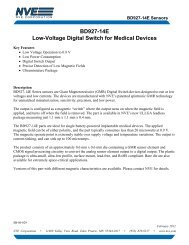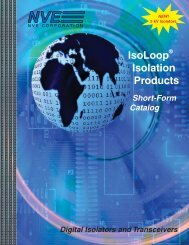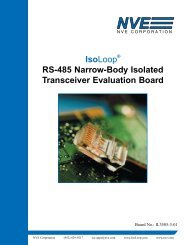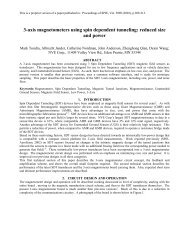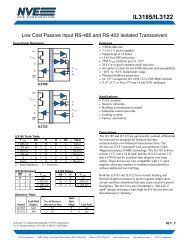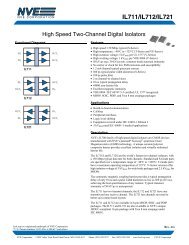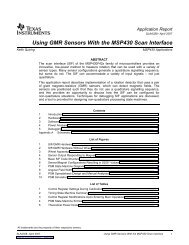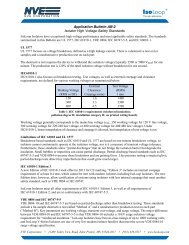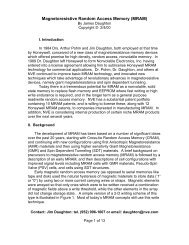very dense magnetic sensor arrays for precision ... - NVE Corporation
very dense magnetic sensor arrays for precision ... - NVE Corporation
very dense magnetic sensor arrays for precision ... - NVE Corporation
You also want an ePaper? Increase the reach of your titles
YUMPU automatically turns print PDFs into web optimized ePapers that Google loves.
Enable8 elementarraySensing currentHostAD7501Device selectV refV outAT MIO16Xseries E I/OAD7503O/PBand-passfilterMultiplexed sense current and output3 bit data busLock-inamplifierV +X and Y signalsFigure 10. Block diagram of the multiplexed dataacquisition system <strong>for</strong> multiplexing a 16-element GMRarray.Device selectV refV outData acquisition systems can also include digitizersand control. The system shown in Figure 11 takes thesignals from 64 <strong>sensor</strong>s in an array <strong>for</strong> biosensing,multiplexes them to an amplifier, and digitizes them. Thecomputer controls the current to an electromagnet whichapplies an ac <strong>magnetic</strong> bias to the sensing elements.Multiplexed output, Parallel sense currentFigure 12. Schematics of multiplexed data acquisition byon-chip FETs. Either the sense current or the outputcan be multiplexed.ApplicationsEdge Connector64 x 1MultiplexerGMR Array ChipDiff.Amp.Digitizer BoardConnector Board12 BitA to DConverterCoil BoardCurrentAmpLaptop / PCFigure 11. Data acquisition system <strong>for</strong> a 64-elementbio<strong>sensor</strong> array. Computer control of applied <strong>magnetic</strong>field is also shownOn-chip multiplexing of <strong>sensor</strong>s reduces the numberof connections to the chip. The multiplexing can beaccomplished by using FETs to select the device to beconnected to an external digitizer as is shown in Figure 12.Multiplexing can be accomplished by selecting the <strong>sensor</strong>to which the sensing current is directed or by using parallelsense current and multiplexing the output.Imaging of <strong>magnetic</strong> media – There are a variety ofapplications that utilize <strong>arrays</strong> of <strong>magnetic</strong> <strong>sensor</strong>s to <strong>for</strong>mimages of various types of <strong>magnetic</strong> media. In<strong>for</strong>mationrecorded on audiotapes by simple tape recorders and eventelephone answering machines has played important rolesin legal cases. It is important to ascertain whether theserecordings are genuine or have been edited. Direct imagingof the <strong>magnetic</strong> patterns on the tape surface can revealstarts and stops and erasures. In some cases, <strong>magnetic</strong>imaging can recover in<strong>for</strong>mation that was erased and is nolonger available in audio playback. The originalin<strong>for</strong>mation may remain as patterns bordering the erasehead or even may be recovered as a faint image in theerased section. Research has been done at the NationalInstitute of Standards and Technology (NIST) in Boulder,Colorado on methods to recover this seemingly lostin<strong>for</strong>mation. 7 An image is slowly acquired one scan at atime using a commercial magnetoresistive read head from acomputer hard drive. Magnetic <strong>sensor</strong> <strong>arrays</strong> cantremendously reduce the time to acquire such in<strong>for</strong>mationand bring this technology out of the research laboratory andinto the <strong>for</strong>ensic laboratory. 8Magnetic imaging using high-resolution <strong>arrays</strong> of<strong>magnetic</strong> <strong>sensor</strong>s has many potential uses in commerce.5



